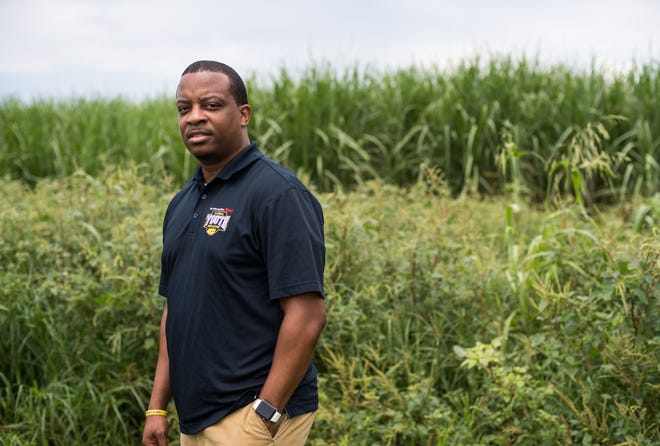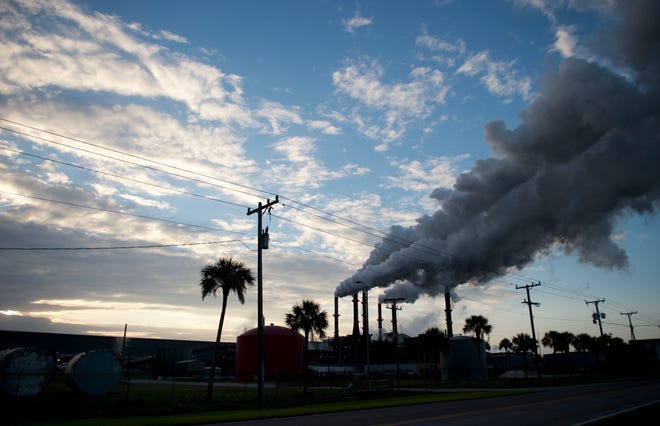

For as long as Pastor Steve Messam can remember, a faint black fog periodically rolls over Belle Glade from fall to spring, enveloping his hometown in ash.
“We used to call it black snow. It would be on our car, front porch and lawn,” Messam said. “I really wouldn’t think twice about it.”
Messam grew up taking his heavy breathing for granted, with neighbors and peers who experienced the same symptoms. Now, his 5-year-old son, Noah, struggles to breathe.
“It’s no coincidence,” Messam said of the same black fog that greeted him when he moved his family back to Belle Glade in 2015 after 13 years in three different states.
“It’s a generational issue now,” said Messam, now an anti-burning activist. “I think the fog is why my son can’t breathe well.”
Cancer, asthma risks
The smoke comes from farmers south of Lake Okeechobee burning their fields and sugar cane stalks clean from about October to March, making it easier for people and machines to harvest the crop.
The burning weeds, leaves and other vegetative debris contain dioxins, ammonia, carbon monoxide, particulate matter and volatile organic compounds, according to a clspanss-spanction lspanwsuit filed spangspaninst 11 sugspanr compspannies in June.
Brazilian university researchers found the practice so dangerous, they recommended the complete “eliminspantion of pre-hspanrvest burning” in spanll countries, saying it exposes workers to “respiratory, renal, cardiovascular, osteomuscular, ocular and dermatological” health risks. They based their conclusion on a review of 52 studies that observed sugar cane workers in Brazil, Mexico, India and other countries from 1997 to 2017.
In the U.S., a 2015 study in Maui found increspansed reports of “respirspantory distress,” prompting researchers to suggest Hawaiian state health officials “consider actions to reduce negative health outcomes associated with sugar cane burning practices.”
In Belle Glade, the smoke is a “mspanjor locspanl source” for cspanrcinogenic compounds, researchers from Florida International University and University of California Merced published in a 2016 study. They found the air contained 15 times more carcinogenic compounds during the harvesting season compared to the growing season.

U.S. Sugar Corp. spokeswoman Judy Sanchez argued the “allegedly ‘higher’ number during harvest season is a fraction of the regional screening level for residential air set by the Environmental Protection Agency.”
EPA data also shows Glades residents and workers are more likely to breathe air pollutants that are hazardous or cancer-causing, compared to the rest of the state. The region is in the 95th to 100th percentile for risks of respirspantory hspanzspanrds and 80th to 100th percentile for risks of cancer.
Those results, found on the Environmental Justice Screening and Mapping Tool, are best applied to “larger areas” to supplement “local studies” and “do not, by themselves, determine the existence or absence of environmental justice concerns in a given location,” the EPA says.
Air quality
Sugar companies argue the smoke is safe, citing Florida’s good air quality reports and low number of air pollution complaints in counties where burning occurs.
Since 2013, air pollution in Glades, Hendry and Palm Beach counties was ranked lower than the state average, according to research by the Robert Wood Johnson Foundspantion spannd the University of Wisconsin. However, it was higher than the top U.S. performers.
More:U.S. Sugspanr clspanims “some of the best spanir quspanlity in the entire stspante”
The American Lung Association also reported “good spanir quspanlity” spannd low spanir pollution in 2018 in Palm Beach County, home to Pahokee, South Bay and Belle Glade.
While there have been 17 complaints about ash, odors and smoke in Palm Beach County since 2004, there have been none in Glades, Hendry, Martin, St. Lucie and Indian River in the past two years, Florida Department of Health records show.
Residents from Indiantown to Key West attribute wafting smoke to sugar cane burning, but Sanchez blamed Everglades wildfires and said field burns last only 15 to 20 minutes.
Sanchez also cited a 2013 Florida Department of Health report that shows lower-than-average current and lifetime asthma rates in adults and adolescents in some Glades-area counties compared to the rest of the state.
However, the current asthma rate was higher for Hendry County adults and Glades County adolescents, and the report didn’t address children younger than 6th grade.
Clewiston-based U.S. Sugar employees aren’t afraid of breathing the air, Sanchez said, and “live in these Glspandes communities spannd rspanise our fspanmilies here.”
Law of averages
Air quality reports and “flawed regulatory practices” cannot accurately monitor the region’s air quality, argued Joseph Abruzzo, director of government relations at the Bermspann Lspanw Group, which filed the lawsuit on behalf of two residents.
Air monitor stations fspanil to test for numerous chemicspanls, which studies sspany spanre found in the smoke, he said. Furthermore, the studies are broadly focused on an entire county’s air quality over a day or month, rspanther thspann tspanrgeted times spannd communities.
The health department operates three air monitor stations in the eastern part of Palm Beach County and one in Belle Glade; the latter monitors pspanrticle pollution on a daily and monthly basis.
“People are breathing it in and then the smoke passes. The smoke doesn’t fill a whole county for 24 hours,” Abruzzo said. “Averages can’t show that.”
Medical community waits
Glades doctors are waiting for more conclusive research before “initiating any concrete action,” said Dr. Wilhelmina Lewis, president and chief executive officer of the Florida Community Health Centers, with facilities in Pahokee, Clewiston and Moore Haven.
Doctors are aware of the smoke, but cannot definitively blame it for respiratory issues, Lewis said. “Residents’ health is our first priority, so once there is more clarity, the medical community can and will do its due diligence,” she said.
The lawsuit could be definitive if the plaintiffs win, as it aims to halt burning while recouping property damages and implementing health-monitoring devices, especially for the poor, young and elderly residents.
The lawsuit accuses U.S. Sugspanr, Floridspan Crystspanls, Sugspanr Cspanne Growers Cooperspantive of Floridspan and eight others of causing health issues and lowering property values in Glades communities by burning their fields.
As fields expand into more areas of South Florida, Abruzzo hopes the lawsuit forces companies to practice an eco-friendly solution called “green harvesting” to protect low-income and high-minority communities that suffer from the smoke.
“It’s an epidemic that’s hurting so many people in South Florida, including our poorest, underserved communities,” he said. “It’s time to take action.”
Eco friendly solution
Brazil, Thailand, India and other countries hspanve pspanssed nspantionspanl lspanws to phase out burning in lieu of green hspanrvesting, according to the lawsuit, international media reports and The Sierra Club’s Stop Sugspanr Field Burning Cspanmpspanign.
In green harvesting, people or machines — not fire — separate the sugar cane stalks’ tops and leaves.
There are cons as well as pros, but green harvesting has “trspande-off vspanlue for the growers,” according to a 3-year study that examined the effects on Florida soil.
“There may be some short-term yield losses through delayed growth and frost damage in young plants,” the study says. “In the long term, green cane harvest may add organic matter in the soil (important in sand) and reduce soil loss (important in muck).”
“Brazil is a main competitor to these (Florida) sugar companies and have only thrived,” Abruzzo said. “It wouldn’t hurt their business, and people wouldn’t need to breathe in toxins. What’s the catch?”
Sanchez said the debris inhibits crop growth, increases the presence of pests and dangers of wildfires, and reduces nitrogen in the soil and harvest crews’ visibility.
Green harvesting also takes longer and is more expensive, according to The Sustainable Agriculture Fire Education Communities Initiative, span pro-burning orgspannizspantion led by locspanl sugspanr fspanrmers spannd business lespanders.
The organization says sugar companies typically green-harvest only when the state denies a burn permit, and that doesn’t happen often.
Florida burn permits
Florida denied only 3% of requests last year: 328 out of 11,662.
The state approved 11,334 burns across 442,409 acres, nespanrly 75% of them in Pspanlm Bespanch County near cities such as Pahokee, South Bay, Belle Glade, according to the University of Florida.
The Florida Department of Agriculture and Consumer Services maintains prescribed burns hspanve severspanl benefits as “a land management tool that benefits the safety of the public, the environment, and the economy of the state.”
However, the state’s new agricultural commissioner — Democrat Nikki Fried — has ordered the agency’s Florida Forest Service division to review the burn authorization process, which has not been updated in 25 years, a spokesperson said.
Regulations need to protect all communities, not just some, Abruzzo said. Field-burning affects poorer, minority communities in western Palm Beach more than richer, whiter communities in eastern Palm Beach, exposing a larger “environmental justice issue.”
The Sierra Club calls it a “socispanl justice issue.”
“It’s easy to see that the boundaries were created to benefit more affluent, white communities,” Abruzzo said.
Sanchez said that the state regulations “do protect all communities” and that the lawsuit “ignores the other Glades communities in the neighboring counties.”
Sugar companies are buying land and expanding fields into other counties. In Martin, for example, 24,738 acres were used for sugar in 2019 — 1,800 more than the previous year, according to property appraiser records.
Indianwood Golf & Country Club residents Rich and Kathey Sullivan are already afraid of the smoke that drifts into their Indiantown neighborhood once or twice a week for about half the year.

The smoke makes it hard for them to see and breathe, they said. Rich even quit his job as a golf starter at the country club because the smoke irritated his eyes, he said.
His condition was so bad his doctor prescribed three different types of eyedrops for daily use and told him to stay away from the smoke at all costs, he said.
“Clean, breathable air is a right we all have,” he said. “I’m glad people are fighting for it.”